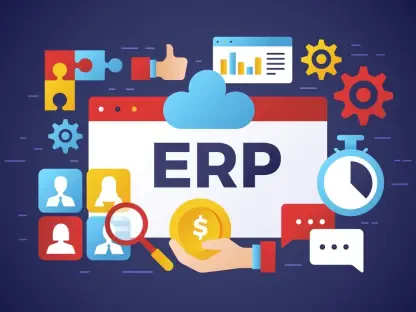The enterprise software industry stands at a pivotal moment, where the fusion of artificial intelligence (AI) with software-as-a-service (SaaS) is redefining how value is created and captured. With nearly half of companies already reporting significant productivity gains from AI integration, the potential for economic impact, estimated in trillions, is staggering. This convergence, often termed AI+SaaS, is not merely a technological upgrade but a fundamental shift in business paradigms, challenging traditional models and opening doors to unprecedented scalability and automation. As companies race to embed AI into workflows, the question looms: how can software providers adapt their strategies to thrive in this transformative landscape?
Understanding the AI+SaaS Landscape
The AI+SaaS ecosystem represents a dynamic intersection of intelligent automation and cloud-based delivery, reshaping the enterprise software sector. Unlike past shifts focused on infrastructure, such as the transition to cloud computing, this era combines AI’s ability to process and act with the accessibility of SaaS platforms. This synergy enables businesses to scale operations rapidly while addressing complex tasks through generative AI, which has become a cornerstone of modern workflows and autonomous agentic use cases.
Key players in this space include established SaaS giants alongside agile AI-native startups, each vying to redefine market standards. Incumbent providers leverage their existing customer bases to integrate AI features, while startups disrupt with innovative, often consumption-driven offerings. The result is a competitive environment pushing the boundaries of what software can achieve, from streamlining operations to driving insights.
Moreover, the addressable market for AI+SaaS extends beyond traditional IT budgets into labor cost savings, unlocking new revenue streams. Generative AI plays a pivotal role here, automating repetitive tasks and enhancing decision-making, thus amplifying the value proposition of SaaS solutions. This technological shift signals a broader industry transformation, where the focus is not just on tools but on outcomes, setting the stage for profound economic impact.
Market Trends and Growth Opportunities in AI+SaaS
Emerging Trends Shaping the Industry
Generative AI has emerged as a disruptive force within the SaaS domain, altering how software delivers value by automating intricate processes. This technology enables platforms to move beyond support functions to actively perform work, fundamentally changing user interactions and expectations. As a result, customers now demand greater transparency in how AI contributes to their operations, alongside scalability to match varying workloads.
Another significant trend is the pivot toward consumption-based pricing models, reflecting the variable nature of AI usage. Unlike static subscription fees, these models tie costs to actual work completed, aligning closely with customer value and fostering adoption. This shift is fueled by competitive pressures, particularly from AI-native startups that prioritize flexibility over traditional pricing structures.
Additionally, the push for productivity gains through AI integration is creating new opportunities for software providers. Companies are increasingly evaluated on their ability to deliver measurable outcomes, driving demand for solutions that enhance efficiency across sectors. This evolving landscape underscores the need for agility, as businesses must continuously adapt to meet heightened customer expectations and fend off emerging competitors.
Market Data and Future Projections
Quantitative insights reveal the rapid growth of AI+SaaS, with 46% of companies noting a productivity or financial impact from AI, a marked increase from prior figures. Enterprise spending on AI applications has surged eightfold to nearly $5 billion, though it remains a small fraction of total software expenditure, indicating vast untapped potential. This data highlights a burgeoning market eager for innovative solutions.
Looking ahead, projections suggest continued expansion, with estimates pointing to a potential economic value of $4.4 trillion from AI-driven productivity improvements. Over the next few years, adoption rates are expected to climb sharply as more organizations integrate AI into core operations. Market analysts anticipate that by 2027, a majority of enterprise software will incorporate AI functionalities, reshaping competitive dynamics.
This growth trajectory underscores the urgency for software providers to refine their offerings and business models. As investment in AI technologies accelerates, the focus will likely shift toward seamless integration and user-friendly interfaces to maximize adoption. These forecasts paint a picture of an industry on the cusp of a major transformation, with significant opportunities for those who can navigate the evolving landscape effectively.
Challenges in Monetizing AI+SaaS Models
Monetizing AI+SaaS presents unique hurdles for software companies striving to align their business models with this new reality. A primary challenge lies in communicating the value of AI solutions, as only 30% of providers publish clear return on investment data from customer deployments. Without transparent metrics, potential buyers struggle to justify the costs, hindering broader acceptance.
Unpredictable pricing further complicates the monetization puzzle, as customers grapple with opaque cost structures that differ from the more stable cloud computing expenses. This lack of clarity can deter adoption, particularly among enterprises seeking budget predictability. Software providers must address this by developing models that offer both flexibility and transparency to build trust.
Post-pilot adoption also poses a significant barrier, often due to inadequate change management strategies. Many AI initiatives falter after initial trials because organizations fail to invest sufficiently in transitioning workflows and training staff. To counter this, companies should prioritize robust change management frameworks, ensuring that the integration of AI tools is sustainable and impactful across all levels of operation.
Regulatory and Compliance Considerations for AI+SaaS
The integration of AI into SaaS platforms brings with it a complex regulatory landscape that software providers must navigate carefully. Laws governing data usage and AI ethics are becoming more stringent, requiring companies to stay abreast of evolving standards to avoid legal pitfalls. Compliance is not just a legal obligation but a critical factor in maintaining customer confidence in an era of heightened scrutiny.
Pricing models are also affected by regulatory frameworks, as transparency in cost structures becomes a compliance issue alongside ethical data handling. Security measures to protect sensitive information are paramount, with breaches potentially undermining trust and triggering regulatory penalties. Software firms must invest in robust cybersecurity protocols to safeguard their offerings and reassure clients.
Furthermore, regulatory changes influence cross-functional operations, from product development to customer engagement. Adapting to these shifts often requires reevaluating internal processes to ensure alignment with legal expectations. As global standards continue to evolve, proactive engagement with regulatory bodies and a commitment to ethical practices will be essential for long-term success in the AI+SaaS space.
Future Directions for AI+SaaS Business Models
The trajectory of AI+SaaS business models points toward a future shaped by rapid technological advancements and changing market dynamics. Advanced agentic workflows, where AI autonomously handles complex tasks, are poised to become a cornerstone of software offerings, pushing the boundaries of automation. These innovations will likely redefine user expectations, demanding even greater integration and efficiency from providers.
Emerging disruptors, particularly AI-native startups, are expected to challenge established players by introducing novel approaches to pricing and functionality. Their agility allows them to experiment with usage-based models that resonate with modern consumers who favor flexibility over fixed costs. This competitive pressure will compel larger firms to innovate continuously to retain market share.
Global economic conditions and regulatory evolution will also play crucial roles in shaping growth areas. As consumer preferences tilt toward transparent, value-aligned pricing, software companies must adapt to these shifts while navigating potential economic headwinds. Staying ahead will require a keen focus on rapid innovation and strategic investments in technologies that anticipate future needs, ensuring relevance in a fast-changing environment.
Conclusion and Strategic Recommendations
Reflecting on the insights gathered, the exploration of AI+SaaS reveals a landscape brimming with potential yet fraught with complexities that demand strategic navigation. The journey through market trends, monetization challenges, and regulatory considerations highlights the critical need for adaptive business models in the software industry. This analysis underscores that the massive opportunity presented by AI integration is tempered by the necessity for clear value propositions and robust operational frameworks.
Moving forward, software leaders should prioritize actionable steps to harness this potential, starting with rapid experimentation in pricing models to identify structures that resonate with diverse customer bases. Investing in transparent communication of return on investment becomes essential to build trust and justify costs, while significant resources allocated to change management ensure sustained adoption beyond initial pilots. Moreover, fostering cross-functional alignment across sales, IT, and finance teams is crucial to operationalize consumption-based pricing and maintain competitive agility. By embracing these strategies, companies can position themselves to capture growth and secure a lasting advantage in the dynamic AI+SaaS era.









